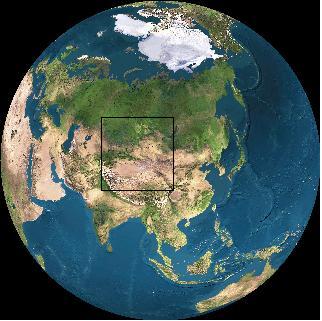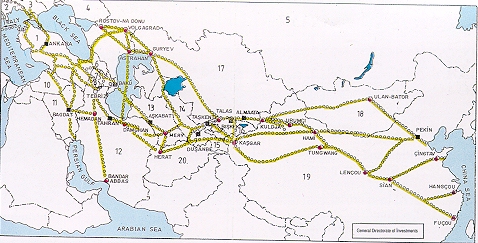|
|
|
| Uyghur Region In The World | |
|
Uyghur Photo Site |
Site Manager |
Contact Page |
Information |
In the World |
Kashgar-Atush |
Turpan |
Urumchi-Qaramay |
Qumul-Korla |
Hoten-Aksu |
Ili-Altay |
Kucha |
People |
Culture |
Nature |
Favorite Links |
Uyghur Photo Guest Book
|
|
|
Geographical Location Of Uyghur Region in the World |
|||
 |
The Uyghur Region
The Uygur region is just in the middle of Europe and Western Asia is not the most hospitable in the world. Much of it is taken up by the Taklimakan desert, one of the most hostile environments on our planet. There is very little vegetation, and almost no rainfall; sandstorms are very common, and have claimed the lives of countless people. The locals have a very great respect for this `Land of Death'; few travellers in the past have had anything good to say about it. It covers a vast area, through which few roads pass; caravans throughout history have skirted its edges, from one isolated oasis to the next. The climate is harsh; in the summer the daytime temperatures are in the 40's, with temperatures greater than 50 degrees Celsius measured not infrequently in the sub-sealevel basin of Turpan. In winter the temperatures dip below minus 20 degrees. Temperatures soar in the sun, but drop very rapidly at dusk. Sand storms here are very common, and particularly dangerous due to the strength of the winds and the nature of the surface. Unlike the Gobi desert, where there are a relatively large number of oases, and water can be found not too far below the surface, the Taklimakan has much sparser resources. |
||
 |
Uyghur Region on the Silk Road
The name "Silk Road" itself was coined by the German geographer Ferdinand von Richthofen in 1877. Traders from East and West usually met each other near the town of Kashgar , roughly halfway along the length of the Silk Road . For over 2,000 years, it was the land route for trade between Asia and Europe. Opened about 139 BC it connected millions of dollars in trade from East to those of the West. If the route was known for anything it was known for its luxuries and precious cargo's. Silk, cashmere, precious jewels, jade, gold, spices; items for those who could afford its luxuries. Silk Road also called SILK ROUTE, ancient trade route that, linking East with the West, carried goods and ideas between the two great civilizations of West and East. East also received Nestorian Christianity and Buddhism (from India) via the road. Originating at Xian, the 4,000-mile (6,400-kilometre) road, actually a caravan tract, followed the Great Wall of China to the northwest, bypassed the Takla Makan Desert, climbed the Pamirs (mountains), crossed Afghanistan, and went on to the Levant; from there, the merchandise was shipped across the Mediterranean Sea. Few persons travelled the entire route, and goods were handled in a staggered progression by middlemen. With the gradual loss of Roman territory in Asia and the rise of Arabian power in the Levant, the Silk Road became increasingly unsafe and untravelled. In the 13th and 14th centuries the route was revived under the Mongols, and at that time Marco Polo used the road to travel to Cathay . The road now partially exists in the form of a paved highway connecting Pakistan and Uyghur Region. The old road has inspired a United Nations plan for a trans-Asian highway. In one word Uyghur Region is situtaed in the Heart of Silk Road |
||
 |
Danger from the Deserts
The land surrounding the Taklimakan is equally hostile. To the northeast lies the Gobi desert, almost as harsh in climate as the Taklimakan itself; on the remaining three sides lie some of the highest mountains in the world. To the South are the Himalaya, Qarakorum ranges, which provide an effective barrier separating Central Asia from the Indian sub-continent. Only a few icy passes cross these ranges, and they are some of the most difficult in the world; they are mostly over 5000 metres in altitude, and are dangerously narrow, with precipitous drops into deep ravines. To the north and west lie the Tangri Tagh and Pamir ranges; though greener and less high, the passes crossing these have still provided more than enough problems for the travellers of the past. Approaching the area from the east, the least difficult entry is along the `Gansu Corridor', a relatively fertile strip running along the base of the Qilian mountains, separating the great Mongolian plateau and the Gobi from the Tibetan High Plateau. Coming from the west or south, the only way in is over the passes |
||